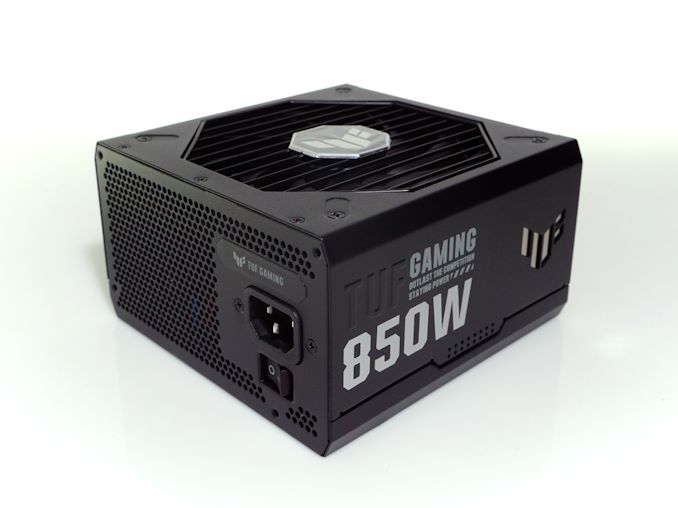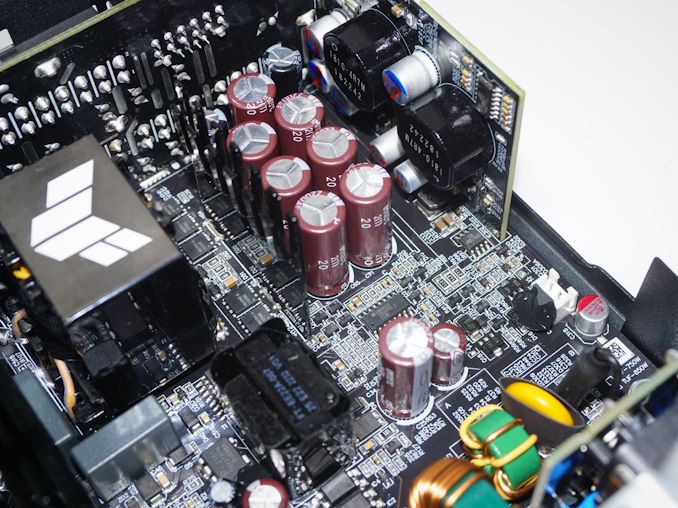The ASUS TUF Gaming 850W Gold PSU Review: Tough But Fair
by E. Fylladitakis on August 31, 2023 9:00 AM EST- Posted in
- Cases/Cooling/PSUs
- PSUs
- Asus
- 80Plus Gold
- ATX v3.0
Power Supply Quality
As part of our testing, we also check output parameters are within specifications, as well as voltage ripple and line noise.
| Main Output | ||||||||
| Load (Watts) | 172.95 W | 431.86 W | 643.96 W | 857.48 W | ||||
| Load (Percent) | 20.35% | 50.81% | 75.76% | 100.88% | ||||
| Amperes | Volts | Amperes | Volts | Amperes | Volts | Amperes | Volts | |
| 3.3 V | 2.23 | 3.42 | 5.57 | 3.4 | 8.36 | 3.39 | 11.14 | 3.38 |
| 5 V | 2.23 | 5.15 | 5.57 | 5.12 | 8.36 | 5.12 | 11.14 | 5.09 |
| 12 V | 12.62 | 12.19 | 31.56 | 12.18 | 47.34 | 12.1 | 63.12 | 12.09 |
| Line | Regulation (20% to 100% load) |
Voltage Ripple (mV) | |||||
| 20% Load | 50% Load | 75% Load | 100% Load | CL1 12V |
CL2 3.3V + 5V |
||
| 3.3V | 1.2% | 18 | 14 | 18 | 22 | 16 | 22 |
| 5V | 1.3% | 20 | 12 | 18 | 22 | 16 | 20 |
| 12V | 0.8% | 28 | 22 | 26 | 36 | 30 | 22 |
Overall, the electrical performance of the ASUS TUF Gaming 850W Gold PSU is very good. It has strict voltage regulation on the major 12V line, fluctuating below 0.8% across the nominal load range. Regulation is not as tight on the 3.3V/5V lines, which are at 1.2/1.4% respectively, but these still are very good performance figures. The filtering on all voltage lines is very good, with optimal results at 50% load. The maximum ripple on all voltage rails occurred at maximum load, with a ripple of 16 mV / 16 mV / 30 mV on the 3.3V / 5V / 12V lines respectively.
As part of our standard testing, we test the primary protections of all PSUs we review (Over Current, Over Voltage, Over Power, and Short Circuit). All of the protections of the ASUS TUF Gaming 850W Gold are engaged normally. The over-current and over-power protection of the unit is markedly lax, allowing the draw of more than 140% of the unit's rated current and 125% of its rated capacity for seconds before shutting the unit down.
Conclusion
The ASUS TUF Gaming Gold power supply unit demonstrates a commendable level of build quality, underscored by the incorporation of high-quality Japanese electrolytic and solid-state capacitors. However, it is worth noting that a notable proportion of electrolytic capacitors and major active components stem from suppliers that may be unfamiliar to the seasoned observer.
Quality-wise, ASUS is placing a lot of resources on the marketing of some of their products as “military grade” equipment, which does raise the eyebrows of more experienced system builders and engineers. To begin with, military designs are minimalistic, often limited to baseline functionality, favoring low cost and resource readiness above everything else – and we can all agree that the design of the TUF Gaming 850W Gold PSU is anything but minimalistic.
What ASUS is doing is that they are having the inductors and capacitors certified by an independent lab to verify compliance with certain standards (in this case, a US Department of Defense standard) – an undeniably nice (and costly) procedure – but, truth is, the Nippon Chemi-Con and Nichicon capacitors found in this PSU are no different than any other of the same series. All equipment manufacturers typically certify their products according to a national or international standard because these are what those involved in the commercial market typically ask for. Some could very well have certifications proving compliance with the US DoD standards as they would need those to directly or indirectly supply certain organizations – we cannot know because manufacturers typically do not publish those test reports publicly. What is certain is that every quality equipment manufacturer certifies their products according to at least one official standard, because no sane equipment procurer would publish a tender or even request a quote for parts that do not come with at least one official certification attached. Finally, the US DoD electronics standards are not actually all that strict, and most of their test methods were issued somewhere between two and six decades ago, making it easy for modern materials and manufacturing procedures to outperform their requirements.
The OEM/ODM affiliation of the ASUS TUF Gaming Gold power supply unit is with Great Wall, a sizable Chinese manufacturer whose presence in mainstream and high-end PC power supply units has emerged only recently. The external design, while captivating, maintains a balance between aesthetics and functionality without veering into the realm of extravagance.
When evaluating power quality, the ASUS TUF Gaming Gold power supply unit offers commendable performance within its class. Its 12V line showcases precise voltage regulation, and the voltage filtering across all voltage rails is notably effective. The energy conversion efficiency surpasses the requirements stipulated by the 80Plus Gold certification, regardless of input voltage conditions.
In terms of thermal performance, the ASUS TUF Gaming Gold exhibits a noteworthy level of resistance to thermal stress. However, in demanding scenarios with extreme loads and elevated ambient temperatures, the cooling profile's relatively lax nature leads to elevated operating temperatures. In terms of acoustics, the ASUS TUF Gaming Gold power supply unit is virtually noiseless during typical operating conditions, even when subjected to substantial loads. The integrated fan remains dormant until the unit's load surpasses fifty percent of its total capacity, contributing to a serene computing environment.
In light of its features, performance, and affordability, the ASUS TUF Gaming Gold offers excellent value at its current price point of $111 in the US. This competitive pricing, combined with its compliance with the ATX 3.0 standard, positions the unit as an attractive choice for those seeking a high-performance power supply solution. Despite minor caveats, the ASUS TUF Gaming Gold stands as a compelling option, addressing the needs of PC enthusiasts and professionals alike, making it a worthy addition to the ASUS TUF Gaming lineup.












8 Comments
View All Comments
Threska - Thursday, August 31, 2023 - link
Minimalistic in it's sameness. Pretty much only thing bringing them out of that is different transistors and RGB.ingwe - Thursday, August 31, 2023 - link
Given the positive conclusion, I think the article headline/title should be changed. Based on that I expected a negative take on the product based on that. Meaning I expected "tough but fair criticism" based on the price/performance etc.Oxford Guy - Thursday, August 31, 2023 - link
He was obligated to have Tough in there because the product is marketed with that word ('TUF').Tough and Fair folk are Great Wall military types, you know.
Igor_Kavinski - Friday, September 1, 2023 - link
Thank you so much for the great review!Samus - Saturday, September 2, 2023 - link
The only thing missing from this PSU is a fan profile switch - something present on many other PSU's in this class, Seasonic "Hybrid Mode" EVGA "ECO Mode" etc.This would greatly help my anxiety when running in the 500w power envelope (which is often where my systems hovers while gaming (depending on the game) with in i7-12700k and RTX 4070Ti. CPU hits PL1 sometimes in Battlefield 2042 but almost no games hit PL2, which would increase the system total power consumption to 650w assuming the GPU was loaded up too. Furmark + CPU burn simulates this, and to get a total system load draw, I have a disk IO torture test running with all SSD's, HDD's, and a few USB 3.0 flash drives to pull some bus power.
This makes an 850w PSU unnecessary for my system, but a little headroom is good for efficiency, longevity and upgradability. The problem is longevity is questionable if this thing is constantly running hot and the fan doesn't turn on at 500-watt sessions. The capacitors especially are rated for a fixed amount of hours at 95-105c and the further you stay away from that range, the longer the cap will last. And tin\lead free solder is not good with heat cycling above 105c that this PSU can hit if ambient temps are high.
Overall its a great product ruined by a bad cooling curve. The fan itself is questionable considering it doesn't even reach its 'rated' RPM. Is it just me or is the appeal of a silent PSU when drawing 500+ watts of power a weird concept. More than likely you are in a game (no single CPU and disk IO will draw 500w) except in edge cases where this PSU is oddly used in a workstation for GPU-based rendering. And if you are in a game, your other components cooling systems are going to greatly overpower whatever sound pressure this PSU's fan hits.
Claudius-07 - Sunday, September 3, 2023 - link
Can someone please explain to an old person: I have a new mobo and it has DDR5 and has 2 8 pin power connectors at the top of the mobo for CPU power. I have the new mobo and a new CPU and the RAM. The video card I bought is a RX 6800. It also has 2 8 pin power connectors. I do not understand, do I need a NEW Power supply ATX 3.0 and PCI5? Do I just need a PS that has at least 4, 8 pin connectors?E.Fyll - Monday, September 4, 2023 - link
Any PSU with two EPS and two PCI Express connectors will do. Note that EPS and PCI Express connectors are different, even if the number of pins is the same. That system does not need an ATX 3.0 compliant unit nor a PCI-E 5.0 connector.RomanPixel - Wednesday, September 6, 2023 - link
Aww man, they didn't change the 12VHPWR connector to a 12V-2x6 before pushing this out.